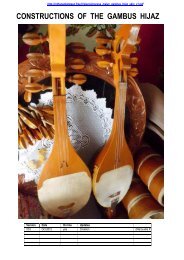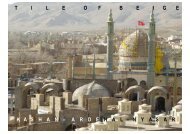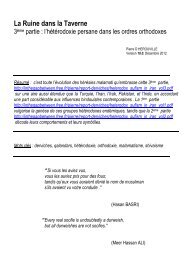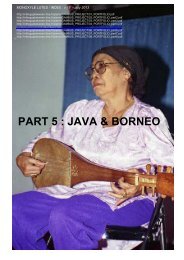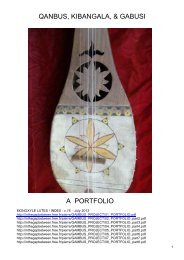Les fakirs Khaksars - In the gap between - Free
Les fakirs Khaksars - In the gap between - Free
Les fakirs Khaksars - In the gap between - Free
Create successful ePaper yourself
Turn your PDF publications into a flip-book with our unique Google optimized e-Paper software.
1.6.3 L’hypothèse Marwandi<br />
Fondé par Lal Shahbaz QALANDAR (Tabriz, 1178 AD, Sehwan Sharif 1274/1323? AD) , un<br />
qalandar charismatique qui se proclama soudainement être une incarnation du Mahdi. Son lignage<br />
spirituel est discutable : on le présente tantôt comme un qalandar, tantôt comme un sheikh de lignage<br />
sohrawardi, via le sheikh sohrawardi Baha ud-Din Zakariya “MULTANI”. La caste de seyyeds de<br />
Sehwan Shariff qui honorent son sanctuaire se revendique à present d’un lignage qadiri…. Le<br />
personnage, également surnommé Lal’- le rubis - ou le « faucon rouge », était fameux pour son habit de<br />
cette couleur.<br />
Cet ordre trouve sa force dans une dévotion mahdiste originale. <strong>Les</strong> adeptes, ascètes hétérodoxes<br />
extravertis habillés en rouge, se retrouvent annuellement au ziyarat de sa tombe, située à Sehwan<br />
Shariff, Sindh. A son instar, ils s’adonnent notoirement à l’alcool et aux hallucinogenes. Si on en croit<br />
Michel BOIVIN, cet édifice s’est substitué à un lieu de culte hindouiste sectaire de BHARTRARI ( divinité<br />
Shivaite) : les ascètes Pashupata, familiers de la danse et de rituels suicidaires, se réunissaient en effet<br />
sur les lieux-mêmes du ziyarat [BOIVIN, 2005]. Celá explique probablement la transe possessive du<br />
rituel Dhammal qui est toujours observé dans le sanctuaire. L’aura de Lal Shahbaz QALANDAR s’etend<br />
jusqu’a la côte de la mer d’Oman, au point qu’il est une figure puissante de l’intercession auprés des<br />
Jinns dans les cultes balochis adorcistes de possessions suivants : « guati », « qalandar » et « pari ».<br />
Enfin, quel peut etre le rapport entre Lal Shahbaz QALANDAR et le lignage Jalali ? Aucun si l’on<br />
en croit la seule silsila jalali-khaksars-gholam alishahiyyah. Cette silsila souligne en effet autant le<br />
lignage qalandari de Jalal Ad Din BUKHARI – en la personne de Khatib Al din Ahm’d Qalandar - que<br />
ses ascendants sohrawardi eminents (FIGURE 1). On doit surtout s’interroger sur l’influence historique<br />
de la Marwandiyyah sur la Jalaliyyah. <strong>Les</strong> annales décrivent Jalal Ad Din BUKHARI et Jalal Ad-Din<br />
KABIR “Makhdum-i-Jahaniyan” (1308-1384 AD), comme des sohrawardis orthodoxes et trés puritains,<br />
tandis que Lal Shahbaz QALANDAR fut un qalandar tolere à la suite de Baha ud-Din Zakariya<br />
“MULTANI”. Or Jalal Ad-Din KABIR “Makhdum-i-Jahaniyan” (1308-1384 AD), apres tant de voyages<br />
pieux, fut precisémment designé par le sultan Muhammad Ibn TUGHLUQ á la tête de la khanqah<br />
sohrawardi de la ville de Sehwan.<br />
« A notorious puritan, Makhdum Jahaniyan strongly deplored <strong>the</strong> <strong>In</strong>dian Muslim religious<br />
customs and ceremonies which had been borrowed from Hindus and were an <strong>In</strong>dian<br />
accretion. He urged that dervishes, Sufis, and ulama visit rulers and government officials<br />
in order to elicit assistance for <strong>the</strong> downtrodden sections of Muslims. He introduced<br />
among his disciples <strong>the</strong> spirit of <strong>the</strong> akhi and futuwwah (spiritual chivalry) organizations<br />
of Anatolia, Khurasan, and Transoxiana. After his death in 785/1384, he was succeeded<br />
by his bro<strong>the</strong>r, Sadr al-Din [NLDR: le saint connu sous le nom de Raju QATTAL], who<br />
achieved fame under his nicknames Raju and Qattal (slayer) for his militant evangelism.<br />
A grandson of Makhdum Jahaniyan moved to Gujarat and before long came to be known<br />
as Qutob-i Alam (The Pole of <strong>the</strong> Universe). He settled in Ahmadabad, <strong>the</strong> newly<br />
founded capital of an independent provincial ruling dynasty of Gujarat. He died in<br />
857/1453 and was succeeded by his son, who came to be known by <strong>the</strong> illustrious title<br />
Shah-i Alam (The Emperor of <strong>the</strong> World), and was also called Shah Manjhan. Qutob-i<br />
Alam, Shah-i Alam (d. 880/ 1475) and <strong>the</strong>ir disciples made Gujarat a leading Suhrawardi<br />
Sufi center of <strong>In</strong>dia. »<br />
[RIZVI, 1978a]<br />
On le voit, Jalal Ad-Din KABIR “Makhdum-i-Jahaniyan”, entreprit de réformer le marwandisme<br />
ambiant de Sehwan. Curieusement, sa branche Jalaliyyah-Makhdumiyyah , originellement d’obédience<br />
sohrawardi orthodoxe, fut submergée ensuite par le modele « errant », au point que les Jalalis sont<br />
aujourd’hui classés parmi les plus hétérodoxes. Au vu des nombreux cas contemporains d’affiliations<br />
d’errants , on peut se demander si ce changement ne s’est pas tout simplement opéré par l’assimilation<br />
progressive de nombreux errants d’obediance marwandi, qalandar, etc... Par ailleurs, en l’absence de




